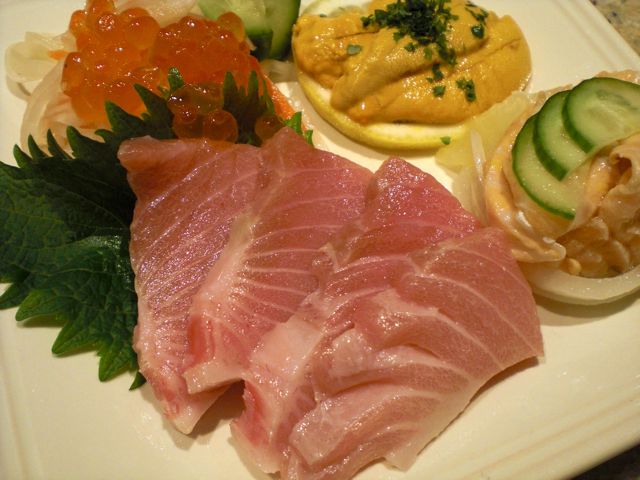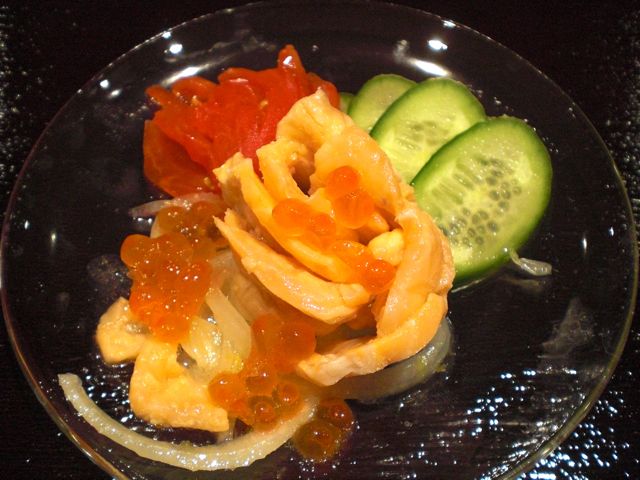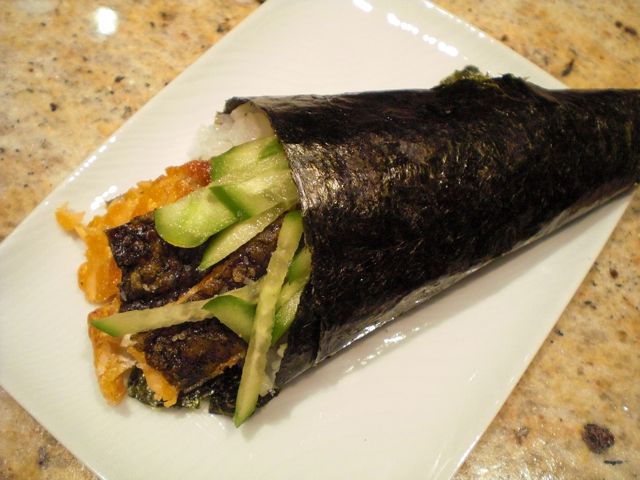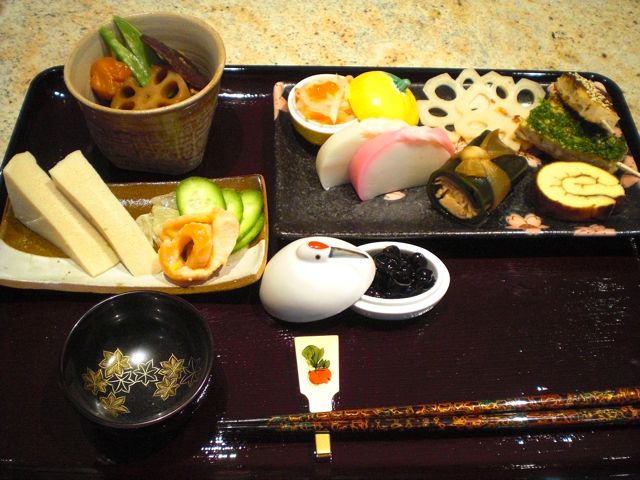If I was cooking outside with a charcoal fire, I would simply grill it with some salt, which is the most simple and wonderful way to eat this. This time, I marinated the salmon belly in Yuuan-ji 祐庵地 (sake:mirin:soy sauce=1:1:2) for about one hour. I skewered and broiled it in a toaster oven for 3-4 minutes each side. I could have made the skin a bit crisper but this is such a nice dish to start with a drink of cold sake. For sure, it is better for you than eating "pork" belly, which is another wonderful belly you can savor. I served this with my usual cucumber with moromi miso もろみ味噌 and Campari tomato with mayonnaise.
Sunday, January 9, 2011
Grilled fatty salmon belly 鮭のハラスの祐庵焼き
Friday, January 7, 2011
Pork scallopini with Pennsylvania dutch egg noodle 豚肉スカルピーニとペンシルバニアダッチエッグヌードル
Wednesday, January 5, 2011
Chicken rice 鶏飯
This was a "shime" 締め we had one weekday evening. This is loosely based on the recipe from "Otsumami yokocho" volume 1, page 132. This dish "keihan" 鶏飯 is supposedly famous in Kagoshima prefecture 鹿児島 but a similar combination of boiled chicken and rice appears to be somewhat universal across the Asian ethnic food cultures with the Hainanese variation best known (we never had this but only saw it in the Anthony Bourdain's No reservations, Singapore episode).

The most important part of this dish is the broth/soup. This is not a recipe to follow but this was what happened. I was vaguely thinking about this dish when I ended up with excess kelp and bonito broth but it took almost 10 days before I finished the broth for this dish. I started this with the leftover Japanese dashi broth (using a dashi pack when I made "snap peas in broth"). I kept the dashi I did not use in the refrigerator for several days. When I deboned chicken thighs for another dish, I warmed up the dashi and added the chicken thigh bones (4) with more sake, slices of ginger and several stalks of scallion and simmered it for 30-40 minutes. I let it cool and again placed it in the refrigerator. The next day, I removed all the bones and congealed fat and strained it to a sealable container and kept it the fridge until today. I first warmed up the broth and gently poached a half skinless, boneless breast for 10 minutes. I took out the chicken breast and set aside. I added more sake, and light-colored "usukuchi" soy sauce 薄口醤油 to taste with a touch of mirin to finish the broth for this dish. This turned out to be a very nice delicate broth with a hint of ginger.
Digression alert: The two kanji letters (ideogram) "鶏飯" in "kun-yomi" 訓読み, or the pronunciation of the letter based on the meaning of the each letter in Japanese, will be "Tori-meshi" but if you pronounced it as such, it indicates a totally different type of a flavored rice dish with chicken meat mixed in. When you pronounce it using the sound related to the original ancient Chinese pronunciation of the letter or "on-yomi" 音読み, then it will be "Kei-han" indicating this dish. Nobody will care but, I am sure, Jon does.
I shredded the poached chicken into thin strands by hand after it was cool enough to handle. I also made "Golden thread omelet" or "kinshiran" 金糸卵 seasoned only with salt, julienne of cucumber and thinly sliced scallion. I just arranged these toppings on warm cooked rice in a bowl (I used frozen and microwaved rice) and poured the warm broth over top. I did not have miso-cured cucumber キュウリの味噌漬け or "Kaiware" daikon sprouts 貝割れ大根, which were called for in the recipe, and I forgot to add sesame seeds.
My wife usually does not like a dish with lots of liquid like "Ochazuke" お茶漬け as a "shime" dish but she really liked this dish especially the broth. She totally emptied the bowl including the broth. Next time, I will try to make the broth in much less than 10 days.
Monday, January 3, 2011
New year's day sashimi, marinaded salmon and salmon skin roll 元旦の刺身, ロシア漬けと手巻きサーモンスキンロール
This is a repeat of last year but we were again lucky enough to receive the shipment of sashimi from Catalina offshore products on December 31. This time we got fresh farm raised "Toro", which had "akami" 赤身, chutoro 中トロ and Ootoro 大トロ on it. In addition, we got anikimo, uni, and salmon roe. Ootoro was quite good. In the picture, the left back is "namasu" なます大根 topped with salmon roe. This year, I added yuzu juice in addition to rice vinegar which added a nice flavor. The golden uni was also excellent as usual (right back).

I also served marinated salmon which is my mother's recipe (right front). This salmon dish is called "Russian marinated salmon" ロシア漬け and my mother does not know how the dish got the name or where she got the recipe*. Of course, I made my contribution (read modification) to the recipe since I think the pith of the lemon imparts a bitter taste to the dish. Essentially, I slice fresh salmon (the original recipe uses salt preserved salmon "aramaki shake" 新巻鮭) fillet paper thin, layered with sliced onion, lemon zest (grated by a micrograter), lemon slices (without the rind and pith). As I lay on the new salmon layer I salt it. The marinade is a mixture of sake, vegetable oil and rice vinegar (1:1:3) but I reduced the amount of oil. I tightly pack the salmon in a sealable container and let it marinade for a few days. The picture below is this dish served stand alone on the next day.

When I made the salmon dish described above, I removed the skin with a bit of the meat attached. Using the skin, I made salmon skin rolls as a "shime" dish. This is a very popular hand roll item in the U.S. but I do not know if any sushi bars in Japan serve this. We like it very much. It is very simple to make, I cooked the salmon skin seasoned with salt, in a frying pan instead of a toaster oven (which is how most sushi bars in the U.S. cook the salmon skin). The skin should be nicely crunchy. I cut the cooked crispy skin into long strips. I used a half sheet of nori crisped up by passing over the gas flame. I smeared real wasabi, added sushi rice, perilla leaf, julienned cucumber and several strips of the salmon skin and made it into a cone shaped hand roll as seen below.

This is a very nice end to your new year's day Izakaya feast.
* I googled (google.co.jp) "鮭のロシア漬け" the marinated salmon recipe and found this blog (in Japanese). The recipe is a very similar to my mother's. According to this blogger, her mother got the recipe from a Japanese magazine "Kurashi no techo" 暮らしの手帖. The recipe is reportedly published in the section called "Apron memo" quite a number of years ago, although the exact year is unclear. Even though the blogger mentioned the recipe was published some time ago, I was eating this as a kid and it is possible my mother's recipe predates even that publication.
* I googled (google.co.jp) "鮭のロシア漬け" the marinated salmon recipe and found this blog (in Japanese). The recipe is a very similar to my mother's. According to this blogger, her mother got the recipe from a Japanese magazine "Kurashi no techo" 暮らしの手帖. The recipe is reportedly published in the section called "Apron memo" quite a number of years ago, although the exact year is unclear. Even though the blogger mentioned the recipe was published some time ago, I was eating this as a kid and it is possible my mother's recipe predates even that publication.
Saturday, January 1, 2011
Happy New Year 2011 明けましてお目出度う御座いました 2011
Saying the New Year's greeting in the past tense must be Hokkadio dialect. My father used to say it this way and my wife somehow picked this up as the correct way to say Happy New Year. Most people, however, will say the greeting in the present tense "明けましてお目出度う御座います".

It seems I have made excuses concerning the New Year feast for 2 years running. Last year, I said I had to work until December 31 and could not make the New Year Boxes or "Juubako" 重箱. This time, I have two major excuses both of which led to a paucity of food products; First one of our favorite Japanese grocery stores closed unexpectedly this year and second because of the recent package bomb scare, my mother's annual New Year's "care package" exceeded the new restrictions to be sent by air--it had to be sent by sea and even though it was sent over a month ago it did not arrive in time. In addtion, we are remodeling our house and the Japanese tea room we usually use to celebrate is not available. In any case, I essentially made everthing in one day on December 31. Although I had to "punt" and use frozen premade vegetables for "Umani" New Year stew (left upper) and used a boiled packaged lotus root "renkon" 蓮根 for sweet vinegared renkon 酢蓮根, the rest is homemade (except the fish cakes and black beans).

Here is our new year soup or "ozouni" お雑煮. We used a hybrid broth of vegetable chicken broth my wife made and kelp and bonito stock.
In any case, we started the new year with a good new year breakfast. Happy New Year!
In any case, we started the new year with a good new year breakfast. Happy New Year!
Thursday, December 30, 2010
Salmon "Ishikari-nabe" hotpot 石狩鍋
Ishikari 石狩 was a small coastal town which is located near Sapporo 札幌 where I grew up. Ishikari river 石狩川 drains into Ishikari bay 石狩湾 and to Sea of Japan 日本海 after winding down the ishikari plain. The river flooded often and meandered around. In the interest of efficiency, human intervention made shortcuts and straightened the water ways. As a result scimitar shaped lakes called "Mikazuki-ko" 三日月湖 were left behind. These lakes are mostly located in the area called "Barato" 茨戸, which is between Sapporo and Ishikari. They were separated from the main river but provided good fishing. Over the years Barato has become a suburbs of Sapporo 札幌. It is well developed but some pockets of wilderness remain.

Ishikari nabe was originally a simple fisherman's stew cooked on the beach using salmon caught in the mouth of the Ishikari river. In the past, salmon were extremely abundant and ran up the ishikari river. The salmon fishery declined drastically for some time but it is making a big come-back because of the continuos release of the hatchlings over many years and improved river management.
We enjoyed this with sprinkles of 7 flavored Japanese red pepper flakes and warmed sake. We have not had warmed sake for ages but I just wanted to try it again. I thought Gekkeikan "Black and Gold" (US brewed) is perfect for drinking warm since it is very gentle sake. It took some effort to find the "ochoushi" お銚子 flask for waming the sake. My wife finally found one (Hagi ware 萩焼) in the back of the cupboard. I gently warmed the flask in a hot water to 118 F (I measured the temperature using a digital instant meat thermometer). Guinomi ぐいのみ is made by an American artist Peggy Loudon, which my wife acquired at one of the Smithonian craft shows held at the building museum in Washington, DC. The warm sake was perfect with this nabe on this cold night--especially since we were anticipating a big snow storm which luckily just missed the Washington area by a hair. We probably will go back to drinking cold sake...warm sake is good on certain occasions but in general we prefer cold sake.
P.S. This recipe was featured in "The Jerusalem post" by Johanna Bailey.
Although Barato is now within commuting distance of Sapporo when my late brother and I were in grade school (9 and 6 respectively) getting there to go fishing was a great adventure--we had to take a bus, which ran infrequently from downtown Sapporo. On one such adventure we were supposed to meet a friend of my father's to go fishing at one of the lakes. He was supposed to wait for us at the designated bus stop in Barato but we somehow missed the stop and ended up at the beach of Ishikari, the terminus of the bus line. The kindly female conductor (this was a time when all buses had conductors) took pity on us and promised to get us to the right bus stop on the return run to Sapporo. Unfortunately, as I mentioned, the bus ran only infrequently and the return trip did not occur until that afternoon. So there we were, two waifs, stranded at the desolate Ishikari beach for several hours getting hungry. The kind conductor once again took pity and bought us a bowl of Ishikari-nabe, for which the city is known, from the near-by eatery where she and the driver were eating lunch. I cannot tell you how great it tasted. The dish I made today was Ishikai-nabe. Making it, smelling it and eating it brought back the long ago memory and evoked this long preamble.
Ishikari nabe was originally a simple fisherman's stew cooked on the beach using salmon caught in the mouth of the Ishikari river. In the past, salmon were extremely abundant and ran up the ishikari river. The salmon fishery declined drastically for some time but it is making a big come-back because of the continuos release of the hatchlings over many years and improved river management.
There are many variations of this dish but, the original form is very simple; put whatever ingredients are available (you must have salmon, though) in a pot. The broth is ususally seasoned with kelp broth and miso. The secret of making a good Ishikari nabe is to put the miso seasoning in after the vegetables are cooked. The other secret is not to cook the salmon too long.
The above picture of Ishikai-nabe is in a small one person pot (8 inch wide), which my wife and I shared. This time I used, daikon (2 inch long, peeled cut thinly in half moon shape), carrot (one medium, cut thicker than daikon in half moon shape), potato (one medium, cut into half inch thick half moon shape) and cabbage (3 leaves, hard veins removed and roughly chopped). In addition, I used fresh shiitake mushrooms (2), shirataki (1/3, parboiled) and scallion (3, cut in a slant) and salmon fillet (whatever amount you like). I thought of adding tofu but the pot was full and I decided not to use tofu this time. You could add other vegetables, sea food, fish cakes etc if you like.
I started by soaking kelp (4-5 inch long) in about 3 cups of water for 30 minutes or longer or until it gets hydrated and soft. I put the pot on a medium flame and when the water started to boil turned down the heat and took out the kelp. I put the vegetables which takes a long time to cook in the pot first (cabbage, potato, daikon and carrot) and cooked them for 20-30 minutes on a low flame.
Preparation of the salmon: I had one medium size fillet of salmon (1 lb). After washing and removing any scales and bones if present, I removed the thin fatty belly part or "harashu" ハラス for another dish. I cut the remaining fillet into one inch wide strips and then cut the strips in half to make good sized rectangles. In order to reduce the strong or gamey taste of the salmon, I parboiled it in boiling water with a small amount of sake for just 10-20 seconds. Then I washed the pieces in cold running water and set aside.
Seasoning mixture: I disolved miso (3 tbs) in sake (1 cup) and mirin (3 tbs) in a measuring cup and set aside. You could adjust the sweetness by increasing or decreasing the amount of mirin.
When the vegetables were done, I added shirataki and shiitake. After few minutes of cooking (with lid on), I added the seasoning mixture above. After coming back to a simmer, I added the salmon and scallion and cooked it until salmon was just done (3-4 minutes). Some people add butter or milk at the end but I did not.
We enjoyed this with sprinkles of 7 flavored Japanese red pepper flakes and warmed sake. We have not had warmed sake for ages but I just wanted to try it again. I thought Gekkeikan "Black and Gold" (US brewed) is perfect for drinking warm since it is very gentle sake. It took some effort to find the "ochoushi" お銚子 flask for waming the sake. My wife finally found one (Hagi ware 萩焼) in the back of the cupboard. I gently warmed the flask in a hot water to 118 F (I measured the temperature using a digital instant meat thermometer). Guinomi ぐいのみ is made by an American artist Peggy Loudon, which my wife acquired at one of the Smithonian craft shows held at the building museum in Washington, DC. The warm sake was perfect with this nabe on this cold night--especially since we were anticipating a big snow storm which luckily just missed the Washington area by a hair. We probably will go back to drinking cold sake...warm sake is good on certain occasions but in general we prefer cold sake.
P.S. This recipe was featured in "The Jerusalem post" by Johanna Bailey.
Tuesday, December 28, 2010
Chicken noodle soup チキンヌードルスープ
Every time I make my version of chicken noodle soup, this "Far side" cartoon by Gary Larson comes to mind. I am sure this slightly "dark side" humor won't appeal to everybody but I found it funny. I have been a fan of Far side for quite some time. Unfortunately, Gary Larson retired some years ago after making more than enough money (I am sure). In any case, I also make a cold-fighting chicken noodle soup, although it may not be quite the same as a Jewish (hen) mother's.
(This cartoon is, no doubt, copyrighted by the Farside, Gary Larson, hope posting it in my blog is OK)
I decided to make this soup not because we had a cold but because my wife made a nice chicken stock from chicken bones (breast and thigh bones, which I produced while deboning chicken for other dishes) and vegetables (onion, carrot, ginger root, celery with bay leaves and black pepper corns). My chicken noodle soup deviates from the traditional in several ways. I use Japanese udon うどん noodle (dry one) and also make my soup thickened. My wife's broth (fat and solids removed after overnight refrigeration) is very nice with the sweetness coming from the vegetables and with a hint of ginger giving an "Oriental or something" touch (no salt added at this point). I usually add either milk or cream at the end (optional). So, this is more a type of chicken noodle stew than traditional chicken noodle soup.
Subscribe to:
Posts (Atom)

